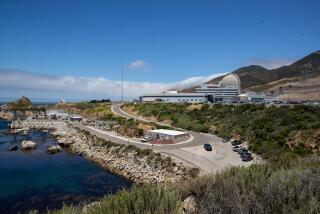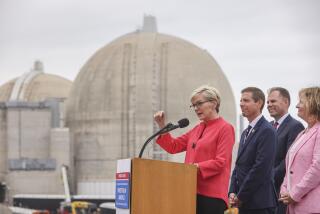NRC Adopts Utility’s Seabrook Evacuation Plan
- Share via
WASHINGTON — The Nuclear Regulatory Commission on Wednesday removed a major obstacle to licensing the Seabrook, N.H., nuclear power plant for low-power testing.
It ruled 4 to 1 that a new utility-drafted evacuation plan for the six Massachusetts municipalities within Seabrook’s 10-mile emergency zone could be considered in lieu of a state proposal.
“We find that the plan is bona fide and in the realm of the possible,” the commissioners said. Approval for a full-power operating license must meet much stricter standards.
New Hampshire Yankee, operator of the plant, submitted its own evacuation plan after Massachusetts Gov. Michael S. Dukakis refused to file a state proposal.
Near Massachusetts Border
Dukakis believes geographic and demographic characteristics of the seacoast area make it impossible to evacuate safely under any conditions, a stance that has further stalled the often-delayed $5.1-billion plant, which is a few miles from the Massachusetts border.
Dukakis called the commission’s decision “extraordinary,” said he was struck by the reference to realm of the possible, and added: “If this is the basis on which the future of families and citizens and communities in this country are being decided, then we are in very, very deep trouble.”
Massachusetts Atty. Gen. James Shannon vowed to challenge a low-power license in federal court.
NRC Chairman Lando W. Zech Jr. said the vote means that Seabrook could get a low-power license within “weeks or perhaps months” if two technical issues pending before the Atomic Safety and Licensing Board are resolved.
Accumulation of Mussels
The licensing board issues involve in-service inspection of steam generator tubes and the accumulation of mussels and other marine life in the cooling systems.
The NRC on Wednesday also approved a full-power license for the third reactor at the Palo Verde nuclear power plant in Arizona, despite earlier concerns over possible defects in its coolant pumps. An ultrasonic inspection had revealed small cracks in the shafts of Unit 1’s coolant pumps.
The 5-0 vote means the facility will become the nation’s largest commercially operated nuclear power plant. Its operator, Arizona Public Service Co., assured the NRC that all three units could be operated safely while pump problems are corrected.
More to Read
Sign up for Essential California
The most important California stories and recommendations in your inbox every morning.
You may occasionally receive promotional content from the Los Angeles Times.










